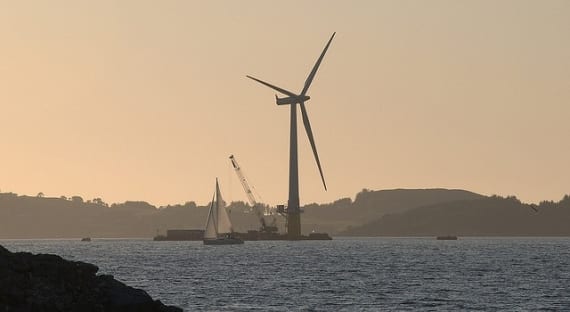A newly formed offshore wind company – backed by at least one deep pocketed international industrial giant – has revealed ambitious plans to develop more than 9GW of offshore and floating wind farms in Australia, and another 3GW in New Zealand.
Oceanex Energy was set up last year by Andy Evans and Peter Sgardelis, two of the founders of Star of the South, which is advancing the massive 2GW project off the coast of Gippsland in Victoria that is likely to be the country’s first offshore wind farm.
OceanEx says plans some 7.5GW of floating wind projects at various locations off the coast of New South Wales, strategically located for the impending exit of the states fleet of coal generators, as well as another 2GW of offshore wind projects in Western Australia. It says it is backed by Green Tower, itself backed by Japan industrial group Daiwa.
Offshore wind farms are yet to be seen in Australia, but massive offshore wind projects are springing up and are planned in northern Europe, the UK and Ireland, the US and in Japan, Taiwan and South Korea, driven by the technology’s falling costs, high capacity factors and low visual impact (at least from land).
Big players are already eyeing opportunities in Australia, including Copenhagen Infrastructure Partners in Star of the South, and oil majors such as BP are thought to be looking at the prospects in Australia as they rush for a share of the global market.
Evans, who retains a small stake in Star of the South, says floating wind is a big opportunity for Australia given its expertise in offshore oil and gas.
Evans told RenewEconomy Oceanex Energy is looking at four big projects in NSW – including near Newcastle, Illawarra and the south coast near Eden, with pre-feasibility, technical and grid studies already under way.
They are all likely to be located 30kms or more out to sea, which means in the case of NSW they will need to be floating wind projects because the ocean will be too deep. But Evans sees this as a great opportunity for Australia’s offshore know-how gained from its massive oil and gas projects.
“We are looking at projects that would be built from 2027 onwards,” Evans tells RenewEconomy. “They will be massive projects, up to around 2GW each, but that is how you bring prices down.”
Offshore wind projects have defied all cost predictions and are already being built in the UK without an additional subsidy – its contracts are based around the market price.
Floating wind farms are expected to follow a similar trajectory and Evans says Australia will benefit from the experience in Taiwan, Japan and South Korea, which he says are about four to five years further down the track to offshore wind.
The key for Oceanex, and other projects such as Star of the South, and two projects announced in Western Australia by Australais and Pilot Energy – will be the anticipated passage of enabling legislation in federal parliament this year.
The offshore clean energy infrastructure act will formalise the creation of offshore wind zones, provide tenure for feasibility licences, a bit like a gas exploration permit, and ultimately a licence to build a project.
“The benefits of offshore wind projects is that they reduce interaction and visual impacts,” Evans says. “A recent World Bank report suggested that 75% of offshore wind will be floating, because they can be located further out to see, have unimpeded winds, and can even be moved, and they are less reliant on the geo-technical features of the sea bed.
“New Zealand is also an interesting market. They had moratorium on new offshore oil and gas for about 18 month …but offshore wind is an absolute give to that industry.
“Offshore wind is attractive to big global funds because they like big investments, and the (oil and gas) industry has knowledge of the maritime environment, and dealing with long term investments with no short term returns.”
Evans says the offshore wind sector requires a unique interface of skillsets – building towers, and turbines, subsea foundations, cables, offshore sub stations, marine logistics. “We are trying to pull everyone together to show there are real options in Australia.”
The Western Australian component would be likely built in shallow water, so not floating wind farms, although the preferred location has not been revealed.
Sgardelis, however, is also a partner in the proposed 5GW Murchison green hydrogen project, led by Hydrogen Renewables Australia and Siemens, one of a number of major green hydrogen plays in that state.










